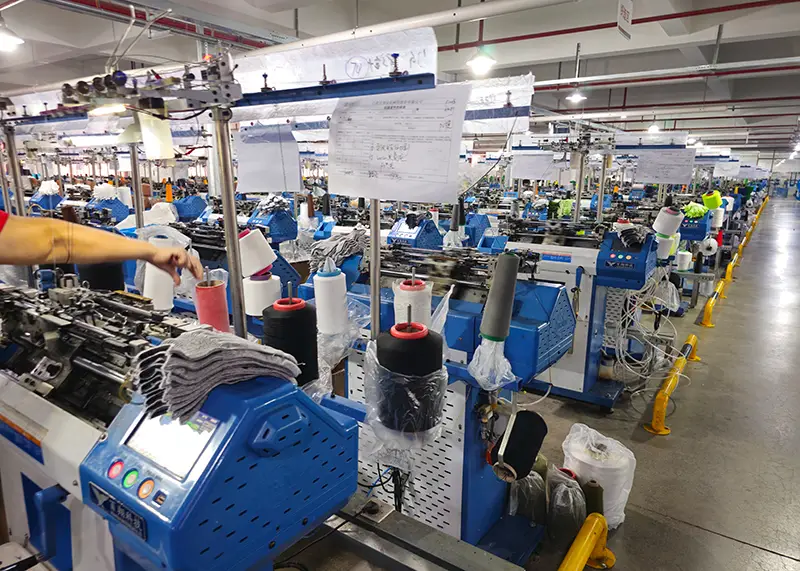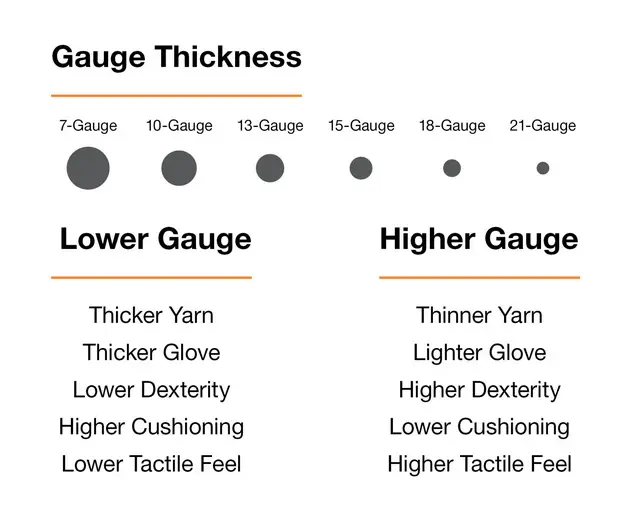 Liner Knitting
Liner Knitting
Factor that determines their performance. But what exactly is a knitting count, and how does it affect the gloves you use?
Bullsafety’s knitting counts, ranging from 10 to 21 gauge, impact everything from glove fit and flexibility to cut resistance and durability, ensuring you get the best protection for your specific needs.
Let’s dive deeper into understanding what knitting count is and how to choose the right one for your business.
Understanding Knitting Count: What It Means for Glove Performance
What does knitting count actually mean, and why is it such a critical factor in glove manufacturing? Let’s break it down.
Knitting count refers to the number of yarns knitted per inch of the glove’s core, directly affecting the glove’s fit, flexibility, durability, and protection level.
 Understanding glove gauge for selecting the right pair based on comfort, protection, and performance.
Understanding glove gauge for selecting the right pair based on comfort, protection, and performance.
The knitting count plays a major role in the gloves’ overall performance. Here’s a closer look at how different counts impact the final product.
What is Knitting Count?
| Knitting Count | Description | Impact on Gloves |
|---|---|---|
| 10 Gauge | Coarser, thicker knit | Offers higher durability but less flexibility. |
| 13 Gauge | Moderate thickness | A good balance of durability and flexibility. |
| 15 Gauge | Medium knit, flexible | Suitable for precise tasks with moderate durability. |
| 18 Gauge | Thinner knit | High flexibility and comfort but reduced durability. |
| 21 Gauge | Very fine knit | Maximum flexibility and sensitivity, ideal for precision tasks. |
The Importance of Knitting Count in Glove Manufacturing
The knitting count affects not only the glove’s strength but also its tactile sensitivity and comfort, crucial for workers who require dexterity and long-term use.
Choosing the Right Knitting Count for Every Application
Different applications call for different levels of glove performance. How do you choose the right knitting count to meet your needs?
Bullsafety offers a wide range of knitting counts that can be matched to your specific application, from heavy-duty protection to fine-tuned dexterity.
Let’s discuss which knitting count works best for specific industries and tasks.
Selecting the Perfect Knitting Count for Your Industry
| Industry | Ideal Knitting Count | Why It’s Ideal |
|---|---|---|
| Construction | 10-13 Gauge | High durability needed for heavy-duty tasks. |
| Electronics | 18-21 Gauge | High flexibility for precision handling. |
| Automotive | 13-15 Gauge | Balance of durability and flexibility. |
| Metal Handling | 15-18 Gauge | Cut-resistance and flexibility in handling metals. |
Flexibility vs. Durability: Which One Matters More?
For tasks requiring fine motor skills, a higher knitting count (18 or 21) provides more flexibility. However, tasks like construction benefit from lower counts (10 or 13) for added durability.
Benefits of Different Knitting Counts: Durability vs. Flexibility
When choosing gloves, you need to consider whether you need more flexibility or more durability. How do the knitting counts impact these factors?
Knitting count directly affects glove durability and flexibility—lower counts are more durable, while higher counts offer better flexibility and sensitivity.
Let’s explore the trade-off between flexibility and durability, and how different knitting counts balance these two essential factors.
Durability vs. Flexibility in Glove Performance
| Knitting Count | Durability | Flexibility | Ideal Use Case |
|---|---|---|---|
| 10 Gauge | High | Low | Heavy-duty tasks like construction. |
| 13 Gauge | Medium | Medium | Versatile for a variety of tasks. |
| 15 Gauge | Medium | High | Precision tasks requiring some protection. |
| 18 Gauge | Low | Very High | Fine motor tasks where sensitivity is key. |
| 21 Gauge | Low | Very High | Tasks requiring maximum dexterity. |
How Knitting Count Affects Performance
The trade-off between durability and flexibility is key to selecting the correct gloves. A higher knitting count offers flexibility, but at the cost of some durability.
How Knitting Count Impacts Flexibility, Fit, and Sensitivity
Flexibility, fit, and sensitivity are crucial in many tasks. How does knitting count affect these factors in glove design?
The knitting count determines how snugly a glove fits and how sensitive it is, especially when working with small components or handling delicate materials.
Let’s dive into the specifics of how knitting count influences fit, flexibility, and tactile sensitivity.
The Role of Knitting Count in Glove Fit and Comfort
| Knitting Count | Fit & Sensitivity | Flexibility |
|---|---|---|
| 10 Gauge | Loose fit, less tactile feel | Limited flexibility, but strong grip. |
| 13 Gauge | Good fit, moderate sensitivity | Balanced flexibility for general use. |
| 15 Gauge | Snug fit, good tactile feel | Good flexibility for tasks requiring dexterity. |
| 18 Gauge | Very snug fit, high sensitivity | Extremely flexible, great for precision tasks. |
| 21 Gauge | Perfect fit, maximum sensitivity | Maximum flexibility for detailed work. |
Fit, Comfort, and Tactile Sensitivity
High-knitting-count gloves like the 18 and 21 gauge offer superior sensitivity, which is essential for tasks where precision is critical.
Optimal Applications for Each Knitting Count Range
What tasks or environments benefit the most from specific knitting counts? Here’s a guide to help you choose the best gloves for your needs.
The optimal knitting count depends on the task at hand—whether it’s construction, electronics, or automotive work, Bullsafety offers gloves for all needs.
Let’s review the optimal knitting count for various tasks and industries.
Best Applications for Knitting Count Ranges
| Knitting Count | Best Application | Why It’s Ideal |
|---|---|---|
| 10 Gauge | Construction, Mining, Heavy Machinery | Provides durability and cut resistance. |
| 13 Gauge | Logistics, Automotive, Metal Handling | Versatile for both flexibility and durability. |
| 15 Gauge | Electronics, Small Parts Assembly | Balances flexibility and protection. |
| 18 Gauge | Fine Assembly, Precision Handling | Offers high flexibility and sensitivity. |
| 21 Gauge | Surgical/Medical, Electronics Manufacturing | Perfect for tasks requiring utmost precision and dexterity. |
Selecting the Right Liner Material for Your Glove Needs
Liner materials play a crucial role in glove performance. How do you choose the right liner material for your gloves?
Bullsafety offers a range of liner materials, such as polyester, nylon, and spandex, allowing you to select the best option based on comfort, protection, and durability needs.
The right liner material ensures that your gloves provide the perfect combination of comfort and protection. Here’s how to choose.
Common Liner Materials for Bullsafety Gloves
| Liner Material | Features | Ideal Use Case |
|---|---|---|
| Polyester | Durable, breathable | Ideal for general-purpose gloves. |
| Nylon | Lightweight, strong | Offers high flexibility for fine work. |
| Nylon & Spandex | Stretchable, comfortable | Provides a snug, flexible fit. |
Advantages of Specialty Liners: HPPE, Glass Fiber, and More
Specialty liners, such as HPPE and Glass Fiber, offer advanced protection. How do these materials enhance glove performance?
Bullsafety’s specialty liners, including HPPE and Glass Fiber, provide exceptional cut resistance, making them ideal for high-risk environments.
Let’s look at how these specialty materials provide superior protection compared to standard liners.
Specialty Liner Materials and Their Advantages
| Liner Material | Benefit | Ideal Use Case |
|---|---|---|
| HPPE | High cut resistance, lightweight | Industrial, metal handling, automotive. |
| Glass Fiber | Enhanced cut resistance, high durability | Heavy-duty and construction applications. |
| Metal Fiber | Superior protection against sharp objects | Used in hazardous environments. |
Quality Assurance of Glove Liners: Consistency and Precision
Maintaining the quality of glove liners is essential for performance. How does Bullsafety ensure precision and consistency in every glove?
Bullsafety follows strict quality control measures, ensuring that every liner meets the highest standards of consistency and precision before reaching the customer.
Bullsafety’s commitment to quality ensures that every glove liner is produced with care, offering reliable protection in every use case.
Consistency and Precision in Liner Production
| Quality Control Stage | Description | Key Benefit |
|---|---|---|
| Raw Material Inspection | Ensure only high-quality fibers are used. | Guarantees durability and safety. |
| Manufacturing Process | Strict quality checks throughout production. | Maintains consistency in every glove. |
| Final Testing | Comprehensive testing before shipment. | Ensures liners meet performance standards. |
Conclusion
Understanding the importance of knitting count and liner materials allows you to select gloves that provide optimal protection, comfort, and flexibility for your business. Bullsafety’s range of knitting counts and specialty liners ensures you get the best product for every application.



